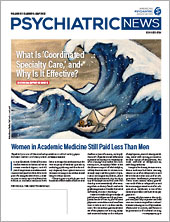Recreational ketamine use may be associated with depressive symptoms in youth, a study in the American Journal on Addictions has found. The study also suggests that more frequent ketamine use is associated with a higher risk of depression.
Joseph J. Palamar, Ph.D., M.P.H., an associate professor in the Department of Population Health at New York University Langone Medical Center, and colleagues examined data from 15,673 youth who participated in the Monitoring the Future survey. The annual survey is administered to middle and high school students in approximately 130 public and private schools in the 48 contiguous states. Researchers drew their data from surveys administered from 2016 to 2019 and focused solely on high school seniors, the majority of whom were at least 18 years old when they took the survey.
In the surveys, participants were asked how much they agreed with the following four statements:
•
Life is often meaningless.
•
The future often seems hopeless.
•
I enjoy life as much as anyone.
•
It feels good to be alive.
Participants rated their agreement as “agree,” “mostly agree,” “neither,” “mostly disagree,” or “disagree.” The researchers then scored the students’ responses and defined students with scores in the top 25th percentile as having a high level of depression.
Participants were also asked how often in the past year they had used alcohol, cannabis, cocaine, ketamine, and heroin and how often they engaged in nonmedical use of prescription amphetamines, opioids, sedatives, and tranquilizers.
The prevalence of high-level depression was 37%, 65%, and 70% greater among participants who used ketamine illicitly 1 to 2 times, 3 to 9 times, or 10 times or more, respectively, in the previous year compared with participants who did not use ketamine. Among participants who used more than one drug in the past year, those who used ketamine had a higher risk of high-level depression than those who did not use ketamine.
Palamar noted that the research did not demonstrate which came first, ketamine use or depression.
“People who are more depressed may simply be more likely to use ketamine as well as other drugs,” he said. He added that most people use alcohol, tobacco, and marijuana before using ketamine. “Most people who use ketamine recreationally are pretty experienced with a range of drugs. I’d hypothesize that many of the teens who used ketamine are teens who were already depressed and used various other drugs as well.”
Only 0.9% of participants had used ketamine in the past year, compared with 53% who had used alcohol and 36% who had used cannabis, yet those who used ketamine had the highest risk of high-level depression.
Smita Das, M.D., Ph.D., M.P.H., chair of APA’s Council on Addiction Psychiatry, noted that ketamine use was low in prevalence and that participants who used ketamine were also likely to use other substances. Das, who was not involved in the research, is an addiction psychiatrist at the Dual Diagnosis Clinic and a clinical associate professor of psychiatry and behavioral sciences, both at Stanford University. “This begs the question—is ketamine use a marker of something else, such as polydrug use, seeking ways to cope as a result of more distress, or some other factor? With the small numbers and pooling the data from 2016 to 2019, ... it is hard to make firm clinical conclusions about ketamine use and depression, aside from a statistical association.”
Both Palamar and Das emphasized the importance of differentiating illicit, recreational use of ketamine from investigational use of ketamine and approved use of esketamine (Spravato) to treat depression.
“Just because a drug administered in a clinical setting can effectively treat depression, that doesn’t mean that is how most people use the drug,” Palamar said. “Most ketamine use is in party settings. Recreational ketamine use has been a staple in nightclub scenes for decades, and it’s commonly used along with [other] drugs. We need more studies examining ketamine use in relation to depression outside of labs as labs are not real-life settings.”
Das warned of the risks of haphazard messaging regarding the potential usefulness of substances that also carry the risk of developing substance use disorders, especially where adolescents are concerned.
“The Monitoring the Future data have repeatedly shown that ... the less risky young people think something is, the more likely they are to do it,” Das said. She said that media stories and legislation that promote “medical” use of substances before there are any major practice guidelines in place may inadvertently encourage and normalize substance use in a way that is unwarranted and even harmful for the public.
“As headlines and industries tout treatments without qualifying the need for use in protocolized ways with medical supervision, the general consumer may seek that substance to find relief. It is important to not get ahead of the science, research, and guidelines, whether it be with ketamine or any other similar substance that could potentially be associated with a substance use disorder.”
This study was supported by the National Institute on Drug Abuse. ■


